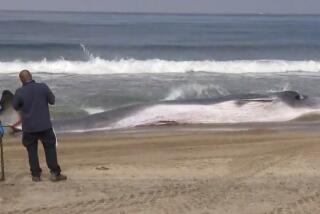Great White Chill : Shark Fears Cut Swimming
On a spectacular day in Newport Beach on Friday, Tom Hunt, 26, wanted to go swimming near the Balboa Pier. But his wife wouldn’t let him.
She was afraid he would not come back.
After hearing that a 20-foot great white shark had been chased from the pier area Thursday afternoon, Hunt’s wife, Helen, 25, said she didn’t want to take chances.
“I want him around a little bit longer,” she said as Tom Hunt, a retail salesman from Fullerton, played in ankle-deep surf with their 3-year-old daughter.
The Hunts were not the only beach-goers who stayed out of the water Friday when lifeguards reopened a 5-mile stretch of beach that had been closed since the shark sighting. Compared to Thursday, when dozens of people played in the ocean, lifeguards said only a handful of body surfers ventured beyond the surf line.
“It did scare a few people out of the area where it was spotted,” said Newport Beach lifeguard Eric Bauer, who estimated the beach crowd Friday at 35,000. “We’re warning people to keep their eyes peeled.”
Lifeguards closed the water to swimmers after a fish, identified by boat skipper Larry Ryan as a 20-foot great white shark, was sighted near the Balboa Pier at about 3:30 p.m. Thursday. Because there were no more sightings, lifeguards said, they reopened the beach. The lifeguards’ boat, Sea Watch, continued watching for it Friday.
Two marine biologists expressed surprise Friday that such a large great white would appear in Orange County waters, and one said it could have been a big but harmless basking shark.
But Ryan, skipper of a commercial towing service, said he came within 3 feet of the monster in his efforts to “herd” it away from swimmers near the pier.
“I was with that fish for 40 minutes, and it kept trying to get in toward the beach,” he said. “I could count its large gills (an identifying mark of a great white) and see its black, beady eyes.”
Ryan, who has fished locally for 12 years and worked for the Harbor Patrol on Santa Catalina Island before that, said: “I’ve seen them all, basking sharks, great whites and all. This one definitely had the stance and the markings of a great white. There’s not a chance it was a basking shark.”
Both he and the skipper of the Sea Watch, which helped in the effort to keep the shark away from swimmers, estimated the fish’s length at about 20 feet.
But Dennis Bedford, a marine biologist for the state Department of Fish and Game, said that
while great white sharks are “distributed worldwide, and we see them quite often off Southern California, I wonder about the identity of this particular shark.”
He said those spotted in this area usually are much smaller, and that Thursday’s fish could have been a basking shark, a harmless species that can grow to well over 20 feet and is similar to the great white in fins, tail and swimming habits.
And earlier, Dennis Kelly, marine biology professor at Orange Coast College, expressed surprise at the appearance of such a large great white here.
Bedford did say, though, that it was possible that a large female great white might visit the Orange County coast “to give birth in the waters that are warmer here than farther north.”
He said commercial fishermen net three or four small ones a year off Southern California, and while their flesh is not tasty, the jaws sometimes are sold as souvenirs.
The experts agreed that great whites pose little danger to swimmers because they rarely venture into shallow waters.
By late Friday, when lifeguards and Harbor Patrol officers from Seal Beach to San Clemente said there had been no more sightings, people returned to the water--except near Balboa Pier. There, even longtime body surfers did not go out over their heads.
Bodysurfing in 5 feet of water, Marco Marzola, 22, said, “It bothered me a little bit, but I don’t think he’s coming in as close as where I’m at.”
Bodysurfer Mark Ropele, 19, was more nonchalant.
“They say the chance of getting eaten by a shark is about the same as getting struck by lightning. I figure I’m not going to get struck by lightning, so I’m not going to get eaten by a shark,” Ropele said.
GREAT WHITE SHARK
Carcharodon carcharias Length: 20-40 feet.
Appetite: Voracious. Attacks seals, sea turtles, large fish, sea lions, tuna, other sharks and occasionally people. Will not attack at every opportunity; can go for long periods without eating.
Attacks on humans: Infrequent. U.S. coastal attacks include off the New Jersey shore, and, with most frequency, along the California coast. Coincide with warmer months, when average surface temperatures vary between 60 and 70 degrees. Most incidents occur during daylight bathing, between 10 a.m. and 6 p.m. The majority of attacks take place in shallows less than 1 meter deep, about 100 meters from shore.
Safety tips: Do not swim or dive alone. Do not swim with an open cut or near speared fish or bait; blood attracts sharks. Avoid thrashing, erratic swimming or splashing that can attract sharks. Avoid light-reflecting apparel.
Source: World Book Encyclopedia
More to Read
Sign up for Essential California
The most important California stories and recommendations in your inbox every morning.
You may occasionally receive promotional content from the Los Angeles Times.










